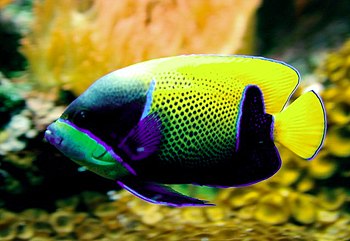 |
| Pomacanthus navarchus (Cuvier, 1831) (Photo credit: Wikipedia) |
Its scientific handle is Pomacanthus Navarchus and they are caught all through the Indo-Pacific seas and even Solomon islands. Thought of as a common large angel, they nevertheless command expensive prices. Juveniles can be obtained for as little as $80-$100 whereas adults typically fetch much more.
Like all members of the large angel family, juveniles wear a distinctly different color pattern than adults. Juveniles are the normal blue, black and white. But their real coloration will start showing themselves as soon as they attain a length of around 3 inches.
From then, their adult coloration will begin to emerge. Adults are very beautiful with a main yellow or orange on its middle body and tail. Also present on this patch are numerous blue dots that are wrapped up in a girdle of sorts. Thus, their common name, the blue girdled angelfish.
Although they can attain a length of 12 inches in the aquarium, this length is particularly rare with the majestic angelfish. As such, they are acknowledged as one of the smaller angels within large angelfish families. They are also one of the least aggressive in this family and usually only show hostility towards other tank mates of the same species.
In their habitats, they are grazers that will feed on algae, corals, polyps, and sponges. In captivity, they will graze on a wide assortment of foods that are both green and meat based. Ensure they are offered a balanced diet.
A good mixture of dry and frozen fish feeds are well suited. Freshly chopped seafood made up of raw squid, clams, fish meat as well as shrimp meat is great. A great pellet brand name to use are those manufactured by New Life Spectrum. Also, make certain they are given ample marine algae in captivity. Seaweed in the form of sheets can be purchased for this intention.
|

No comments:
Post a Comment